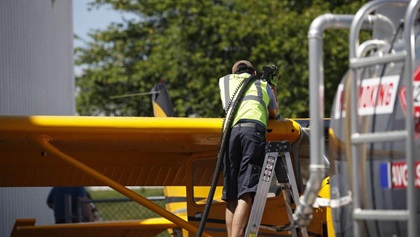ASI Tips: Faulty assumptions
Avoiding fuel exhaustion

And when required gear (suitcases, survival kit) and passengers are non-negotiable, pilots often turn to fuel to come out below gross. But sometimes, we push it too far—fuel exhaustion accidents continue to occur every year.
Of all the factors that lead to aircraft accidents, fuel is one of the easiest to address. If you know your fuel system, verify that you have the right type and quantity of fuel, lean your engine properly, and stay alert to changing conditions, the odds of a fuel-related incident are virtually nonexistent. Here are some tips to avoid fuel exhaustion:
- Be present every time your aircraft is fueled. Verify fuel grade, quantity, and tanks to be filled.
- Check for water or contaminants.
- Secure fuel caps after you check the tank and double-check them before engine start.
- Determine available fuel in hours and minutes instead of gallons and pounds, and plan to land with at least an hour of usable fuel.
- Lean the mixture to achieve the best performance, range, and endurance.
- Recalculate range and endurance hourly to maintain adequate reserves.
- Understand how and when to use boost pumps, auxiliary tanks, and fuel transfer pumps, and switch tanks before reaching pattern altitude.
- Use a timer to remind you to switch tanks during flight.
If you do become low on fuel, land as soon as possible, and if you get close to running out, don’t be shy or embarrassed—declare a fuel emergency with ATC to get priority handling.
These tips may seem overly basic, but even experienced pilots make mistakes, sometimes with severe consequences. In the early morning light on April 22, 2019, the pilot of a Beechcraft Baron 58 preflighted his aircraft at West Houston Airport in Texas, before heading to the terminal to greet his five passengers. The flight was planned to take just over one hour. But the pilot’s mistaken belief about existing onboard fuel proved disastrous.
Join the AOPA Air Safety Institute as we follow the Baron’s flight and learn how an unfortunate chain of events ultimately led to tragedy.

 Depending on your flight school’s refueling methods, it’s possible that you will never have to learn how to use a self-serve fuel pump before the checkride. This would be a mistake! Make sure your CFI teaches you how to refuel on your own. Planning to only fly to places with full-service fuel available isn’t realistic, and if (when) you need to divert one day, you’ll be more prepared knowing you can handle refueling by yourself, and less likely to push your fuel reserves.
Depending on your flight school’s refueling methods, it’s possible that you will never have to learn how to use a self-serve fuel pump before the checkride. This would be a mistake! Make sure your CFI teaches you how to refuel on your own. Planning to only fly to places with full-service fuel available isn’t realistic, and if (when) you need to divert one day, you’ll be more prepared knowing you can handle refueling by yourself, and less likely to push your fuel reserves. 

